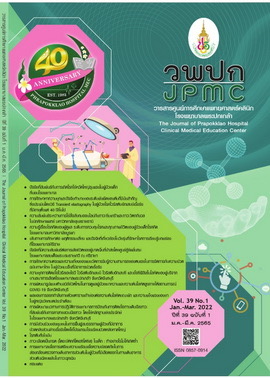The Development of Nursing Practice Guidelines by Using Evidence-based Practices to Reduce Catheter-associated Urinary Tract Infection in Prapokklao Hospital
Main Article Content
Abstract
BACKGROUND: Catheter-associated urinary tract Infection (CAUTI) is one of the top three infections in Prapokklao Hospital, Chanthaburi, Thailand. The trend of the incidence density of CAUTI rose from 2.59, 2.78, and 3.25/1000 device days in the fiscal years 2016-2018, respectively. This was higher than the hospital target (<2/1000 device days).
OBJECTIVES: To develop and evaluate the nursing practice guidelines for the prevention of CAUTI based on the NOCAUTI bundle concept.
METHODS: The population and sample were all indwelling urinary catheter patients in Prapokklao Hospital from October 2017 to August 2021. The evidence-based nursing practice guidelines for the prevention of CAUTI was developed by using an evidence-based practice process integrated with the PDSA cycle of quality improvement and multidisciplinary approach. The steps comprised 1) Identifying the clinical problem, 2) using the PICO format for searching for the evidence, 3) appraising the evidence, and 4) applying the evidence and developing nursing practice guidelines that emphasized the catheter removal criteria integrated with the establishment of a nursing supervision system and multidisciplinary team approach, as well as reminding of the CAUTI prevention by using a NOCAUTI bundle concept. This concept consisted of N-Need, O-Obtain patient consent, C-Competency, A-Aseptic technique, U-Unobstructed flow, T–Timely, and I-Infection risk and was implemented into the clinical practice. 5) The outcome of the evaluated processes used a control U-chart of the CAUTI rate and evaluated the efficacy of the guidelines during the study period from December 2019 to August 2021.
RESULTS: The control U-chart analysis showed a statistically significant reduction of the CAUTI. This also decreased at 1.70/1000 device days in 2021.
CONCLUSIONS: The NOCAUTI bundle could effectively reduce CAUTI in accordance with the hospital target (<2/1000 device days). The key measures were the catheter removal criteria together with the establishment of a nursing supervision system, as well as the strategies of the multidisciplinary team approach and dialogue.
Article Details

This work is licensed under a Creative Commons Attribution-NonCommercial-NoDerivatives 4.0 International License.
References
Kananyt T. Distribution of catheter associated urinary tract Infection in ward nurse at Phen Hospital. Udonthani: Muang Udonthani District Public Health Office; 2556.
Gould CV, Umscheid CA, Agarwal RK, Kuntz G, Pegues DA. Guideline for prevention of catheterassociated urinary tract infections 2009. [Internet] 2019[cited 2021 Mar 15]. Available from: https://www.cdc.gov/infectioncontrol/pdf/guidelines/cauti-guidelines-H.pdf
Durant DJ. Nurse-driven protocols and the prevention of catheter-associated urinary tract infections: a systematic review. Am J Infect Control 2017;45:1331-41.
Oman KS, Makic MB, Fink R, Schraeder N, Hulett T, Keech T, et al. Nurse-directed interventions to reduce catheter-associated urinary tract infections. Am J Infect Control 2012;40:548-53.
Meddings J, Saint S, Krein SL, Gaies E, Reichert H, Hickner A, et al. Systematic Review of interventions to reduce urinary tract infection in nursing home residents. J Hosp Med 2017;12:356-68.
Giles M, Watts W, O'barien A, Berenger S, Paul M, McNeil K, et al. Does our bundle stack up! Innovative nurse-led changes for preventing catheter-associated urinary tract infection (CAUTI). Healthc Infect 2015;20:62-71.
Bohm D. On Dialogue (Routledge Classics). 2 nded. London: Routledge; 2004.
Jensen KA. 7 Steps to the perfect PICO search evidence-based nursing practice. Massachusetts: EBSCO Health; 2018.
Gupta SS, Irukulla PK, Shenoy MA, Nyemba V, Yacoub D, Kupfer Y. Successful strategy to decrease indwelling catheter utilization rates in an academic medical intensive care unit. Am J Infect Control 2017;45:1349-55.
Oman KS, Makic MBF, Fink R, Schraeder N, Hulett T, Keech T, et al. Nurse-directed interventions to reduce catheter associated urinary tract infections. Am J Infect Control 2012;40:548-53.
Hanchett M. Preventing CAUTI : A patient-centered approach. Prevention Strateg; 2012: Autumn:42-50.
Durant DJ. Nurse-driven protocols and the prevention of catheter-associated urinary tract infections: a systematic review. Am J Infect Control 2017;45:1331-41.
The healthcare Accreditation Institute (Public Organization). Hospital and health care standards 4th . Nonthaburi: The healthcare Accreditation Institute (Public Organization); 2018.
Bamrasnaradura Infectious Diseases Institute. Guide to diagnosis of infections in hospitals. Bangkok: Aksorn Graphic And Dedign Publishing Limited Partnerdhip; 2018.
Parry MF, Grant B, Sestovic M. Successful reduction in catheter-associated urinary tract infections: focus on nurse-directed catheter removal. Am J Infect Control 2013; 41:1178-81.
Kitbunyonglert S, Sornsawas S Tamtab N, Pandang J. The effect of urinary catheter removal reminder on catheter-associated urinary tract infection .Thai Red Cross Nursing Journal 2016;9(2):104-18.

